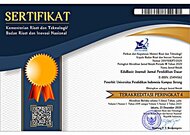Analisis Butir Soal IPS Kelas V Sekolah Dasar Menggunakan Software ITEMAN
Abstract
Keywords
Full Text:
PDFReferences
Allen, M. J & Yen, W. M. (1979). Introduction to Measurement Theory. Texas: McGraw-Hill
Anderson, L. W. (2003). Classroom Assessment: Enhacing The Quality of Teacher Decision Making. New Jersey: Lawrence Erlbaum Associates Publishers.
Amalia, A. N. & Widayati, A. (2012). Analisis butir soal tes kendali mutu kelas XII SMA mata pelajaran ekonomi akuntansi di Kota Yogyakarta tahun 2012. Jurnal Pendidikan Akuntansi Indonesia, 10(1), 1-26.
Azwar, S. (2016). Tes Prestasi: Fungsi Pengembangan Pengukuran Prestasi Belajar. Yogyakarta: Pustaka Pelajar.
Crocker, L. & Algina, J. (2008). Introduction to Classical and Modern Test Theory. Mason, Ohio: Nelson Educatoin, Ltd.
Kartowagiran, B. (Oktober 2012). Penulisan butir soal. Makalah disampaikan pada Pelatihan Penulisan dan Analisis Butir Soal bagi Sumber Daya PNS Dik-Rekinpeg, di Hotel Kawanua Aerotel.
Kemendikbud. (2013). Peraturan Menteri Pendidikan dan Kebudayaan RI Nomor 66 Tahun 2013 tentang Standar Penilaian Pendidikan. Jakarta: Kementerian Pendidikan dan Kebudayaan.
Kemendiknas. (2007). Permendiknas Nomor 20 Tahun 2007 tentang Standar Penilaian. Jakarta: Kementerian Pendidikan dan Kebudayaan Nasional.
Mahjabeen, W., Alam, S., Hassan, U., Zafar, T., Butt, R., Konain, S., & Rizvi, M. (2017). Difficulty index, discrimination index and distractor efficiency in multiple choice questions. Annals of Pakistan Institute of Medical Sciences, 13(4), 310–315.
Mardapi, D. (2017). Pengukuran Penilaian dan Evaluasi Pendidikan Edisi 2. Yogyakarta: Nuha Medika.
Reynolds, C. R., Livingston, R. B., & Willson, V. (2010). Measurement and Assessment in Education. New Jersey: Pearson Education International.
Linn L. R. (1989). Educational Measurement. New York: Mc Millan Publishing.
Wibawa, E. A. (2019). Karakteristik butir soal tes ujian akhir semester hukum bisnis. Jurnal Pendidikan Akuntansi Indonesia, 17(1), 87-96.
DOI: https://doi.org/10.17509/ebj.v1i2.26474
Refbacks
- There are currently no refbacks.
Copyright (c) 2019 Universitas Pendidikan Indonesia
This work is licensed under a Creative Commons Attribution 4.0 International License.
This journal is indexed by




.png)




.png)
1.png)


1.png)

.png)